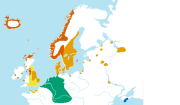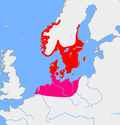An obstruent (/ˈɒbstruːənt/ OB-stroo-ənt) is a speech sound such as [k], [d͡ʒ], or [f] that is formed by obstructing airflow. Obstruents contrast with...
2 KB (229 words) - 06:19, 25 February 2024
/ / and ⟨ ⟩, see IPA § Brackets and transcription delimiters. Final-obstruent devoicing or terminal devoicing is a systematic phonological process occurring...
17 KB (1,623 words) - 12:13, 13 August 2024
Lateral consonant (redirect from Obstruent lateral)
may be added to the approximant. Nearly all languages with such lateral obstruents also have the approximant. However, there are a number of exceptions,...
17 KB (1,737 words) - 11:24, 29 September 2024
letters for many voiceless and modally voiced pairs of consonants (the obstruents), such as [p b], [t d], [k ɡ], [q ɢ], [f v], and [s z]. Also, there are...
6 KB (775 words) - 01:58, 28 August 2024
occur as a coda. ** Conventionally transcribed /r/ In the table, when obstruents (stops, affricates, and fricatives) appear in pairs, such as /p b/, /tʃ...
228 KB (23,166 words) - 07:20, 25 September 2024
Rendaku (section Nasal and unvoiced obstruent clusters)
dakuten (voicing mark). The voiced obstruent consonants of modern Japanese go back to prenasalized voiced obstruents of Old Japanese. Rendaku may have...
25 KB (2,605 words) - 04:24, 4 September 2024
Proto-Indo-European root (section Obstruent clusters)
'small'. The obstruent slot of an onset or coda may consist of multiple obstruents itself. Here, too, only one member of each subgroup of obstruents may appear...
24 KB (2,859 words) - 18:10, 11 August 2024
consonants (and some clusters, e.g. in Icelandic, most clusters of obstruent to obstruent + [r], [j] or [v], such as [pr], [tj], [kv] etc.); short vowels...
112 KB (8,843 words) - 03:10, 21 September 2024
is rarely seen if it would leave a final voiced obstruent. A very few words with final voiced obstruents do occur, such as sed ('but') and apud ('next to')...
45 KB (5,017 words) - 00:44, 21 July 2024
Na-Dene languages (section Obstruent correspondences)
palatals and velars, correspondingly) as well as a general absence of labial obstruents (except where /b/ has arisen from *w). In the historical phonology there...
34 KB (3,252 words) - 07:57, 12 September 2024
"mirage"; however, in a word-final position or when followed by a voiceless obstruent, it is devoiced to the voiceless retroflex fricative ([ʂ]). Its pronunciation...
5 KB (288 words) - 23:14, 19 May 2024
Japanese phonology (section Moraic obstruent)
phonemic analysis treats all geminate obstruents as sequences starting with the same consonant: a "mora obstruent" /Q/. In this analysis, [ak̚ka], [issai]...
196 KB (21,914 words) - 07:41, 2 October 2024
Bühnendeutsch (section Obstruents)
German. The lenis obstruents /b, d, ɡ, d͡ʒ, v, ð, ʝ, z, ʒ/ are fully voiced [b̬, d̬, ɡ̬, d̬͡ʒ̬, v̬, ð̬, ʝ̬, z̬, ʒ̬] after voiceless obstruents so abdanken 'to...
6 KB (650 words) - 20:38, 20 August 2024
grammatical consequences – as well as the use of modal particles, final-obstruent devoicing, and (similar) word order. Dutch vocabulary is mostly Germanic;...
190 KB (19,011 words) - 20:10, 30 September 2024
(depending on the dialect) voiceless fricatives; (4) a set of voiced obstruents—/b/, /d/, /ɡ/, and sometimes /ʝ/—which alternate between approximant and...
228 KB (16,290 words) - 06:35, 2 October 2024
world. Final obstruent devoicing is the full devoicing of final obstruents that occurs for some AAVE speakers in Detroit where obstruents are devoiced...
30 KB (3,339 words) - 22:54, 28 July 2024
are considered to be the more "basic" or unmarked members of the Korean obstruent series. The "plain" segments are also distinguished from the tense and...
74 KB (5,548 words) - 22:18, 30 September 2024
allowed continuant + obstruent clusters in medial and final position only: Fricative + obstruent: ft, ht, fs, hs, zd Nasal + obstruent: mp, mf, ms, mb, nt...
130 KB (12,136 words) - 10:03, 15 September 2024
Wiley-Blackwell 2020. ISBN 978-1119700609 The Typology and Modelling of Obstruent Lenition and Fortition Processes. Budapest: Akadémiai Kiadó, 2003. ISBN...
4 KB (140 words) - 12:31, 12 January 2023
(全清, voiceless unaspirated obstruent), "partly clear" (次清, voiceless aspirated obstruent), "fully muddy" (全濁, voiced obstruent) and "partly muddy" (次濁,...
15 KB (1,592 words) - 16:57, 30 September 2024
a (PIE) stop (p, t, k). CT− After a (PIE) obstruent (p, t, k, etc.; s). C(T) Before or after an obstruent (p, t, k, etc.; s). CH Before an original laryngeal...
112 KB (10,231 words) - 22:10, 4 September 2024
devoiced [m̥, n̥, ŋ̊, ɲ̊, l̥, ɾ̥, w̥] after a voiceless obstruent and optionally after a voiced obstruent which was devoiced. For example, wiatr ('wind') is...
81 KB (7,446 words) - 20:58, 26 July 2024
closure of a voiceless obstruent, basically equivalent to an [h]-like sound preceding the obstruent. In other words, when an obstruent is preaspirated, the...
15 KB (1,664 words) - 16:51, 1 October 2024
represents: A voiced alveolar sibilant /z/ before vowels (except after obstruents), as in 'sich'. A voiceless alveolar sibilant /s/ before consonants or...
22 KB (2,065 words) - 02:51, 16 September 2024
in words with back vowels, but exceptions occur in loanwords. Voiced obstruents syllable-finally become devoiced. Kazakh has a system of 12 phonemic vowels...
39 KB (2,306 words) - 16:41, 14 September 2024
southern Catalonia. It has merged with /b/ elsewhere. Voiced obstruents undergo final-obstruent devoicing: /b/ > [p], /d/ > [t], /ɡ/ > [k]. Voiced stops become...
160 KB (11,660 words) - 20:37, 1 October 2024
tone). Light syllables (syllables with short vowels and optionally also obstruent codas) do not have the two-way contrast of heavy syllables. The first...
113 KB (10,267 words) - 03:34, 14 September 2024
consonant is an obstruent consonant which originally contrasted, and often still contrasts, with an analogous voiced or voiceless obstruent by means of a...
8 KB (757 words) - 00:26, 4 August 2024
of words or after nasal vowels. At the end of a phrase, due to final-obstruent devoicing, they may even be devoiced to [ɸ], [θ], and [x] (for example...
160 KB (14,228 words) - 16:08, 1 October 2024
required] West Frisian has final obstruent devoicing and so voiced obstruents are merged with the voiceless obstruents at the end of words. Thus, word-final...
22 KB (2,042 words) - 09:20, 30 September 2024













